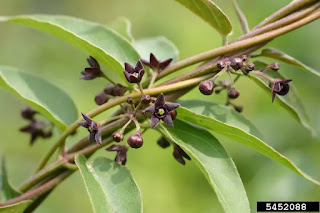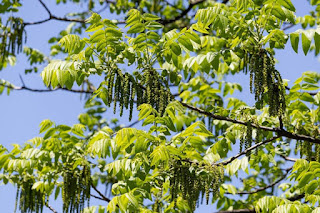Mile-A-Minute AKA Polygonum perfoliatum or Persicaria perfoliate
Over the last several years I have seen Mile-a-Minute vine growing in several areas around Scotland and its adjacent towns. The plant is native to India and East Asia where It is used medicinally. Mile-a- Minute is an annual vine, one that dies back at the end of every growing season. New plants emerge the following year, germinating from seeds that were produced by the plant the year prior. You might wonder how an annual plant that dies back completely every year can be invasive. As its common name Mile-a-Minute suggests, the vine with its unusual triangular leaves and clusters of pretty blue seed filled berries, grows very rapidly up to 6 inches a day and up to a total of 20 to 30 feet in its one growing season! The pendulous clusters of berries drop off very easily when the vine is disturbed. Mile-a-minute vine has tiny barb like thorns aong h stem which help it to climb adjacent trees and vegetation. The seed containing berries fall from the vines which have climbed high up into the trees and shrubs. They end up being widely distributed below eventually germinating and creating more plants the following year. Some of the seeds are also consumed by birds and animals. After passing through their digestive tracts the still viable seeds are dropped by them on their travels, thus allowing the plant to germinate and colonize in an entirely new area. Mile-a-minute prefers to grow on wet soil in sunny locations. It can grow along stream banks or wetlands where seed can be carried by water.
I saw this plant for the first time many years ago when following a trail of mysterious flag like markers leading through the forest to the banks of the Shetucket River. There it was an unusual and very distinctive looking plant that I had never seen before. After a little sleuthing, I discovered UCONN Agriculture was doing an experiment introducing a host specific insect (a little more on that later). More recently I noticed Mile-A-Minute growing along the roadside on Jerusalem Road in Windham, and even more recently along a roadside adjacent to a wetland here in Scotland. Since then, I have seen it distributed in several other areas throughout our town. Even during the winter, this is an easy plant to spot, as the remains of the vine leave a brown net like blanket over every tree and shrub covered during its summer growth. I tried pulling some of the vine out the summer I first noticed it growing on Station Rd. By the time I saw it, it was a little too late in the season as the vine had already developed sharp barbs and plentiful berries. The berries just tumbled off in profusion as I uprooted and pulled the vine from its supports. Never-the-less I filled several large garbage bags before I found the vine had woven itself through a thorny multiflora rose. It was at that point I was forced to surrender. There is no question, an attempt to remove invasive plans can at times feel overwhelming.
HOW TO REMOVE
For small populations of this annual plant hand pulling during its early growth is recommended. The barbs become stiffer as the plant matures so it is easier and less physically painful to pull young plants. Gloves will help, and it should go without saying that it is best, if possible, to pull plants before berry/seed formation. Even immature seeds have the potential to germinate. If infestations are larger, mowing is considered a good option. It is best done regularly so that the plant does not get a chance to develop seeds. If you will be mowing, be certain to check the mower and blades afterward. You do not want to inadvertently move seeds or plant parts to another location and start a new infestation. Another option is using a string trimmer to cut the plants to ground level. In larger infestations preemergence herbicides can be effective. There are a couple that are recommended, and timing of application is crucial for them to be effective. Application instructions are a little lengthy, so I will direct you here for more information http://extension.psu.edu/mile-a-minute.com.
Biologic Control
Back to those mysterious flag-like markers. I found that UCONN had been conducting an experiment along the banks of the Shetucket River with a host specific weevil called Rhinoncomimus latipes. It was found that the weevil will not eliminate Mile-A-Minute, but it does weaken the plant by consuming its leaves therefore helping to stunt the plant's growth. Interestingly the colonies of this plant that I located recently all exhibited holes in their leaves, signs that the weevil was in fact munching on the plant. On its own, the weevil had traveled from the Shetucket River and infested all of the other colonies of Mile-a-minute plant that I discovered, so this insect is having an impact. If you spot large colonies of this plant that are not yet hosting the weevil, it is perfectly fine to transport portions of a plant that are infested to the new area. The best long-term solution is to suppress the growth of this vine long enough for other native plants and especially trees to gain footing. Once that happens, it should help to eliminate the sunny area mile-a-minute requires to thrive.









